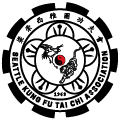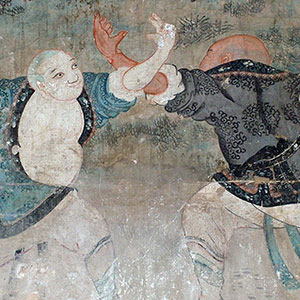
HISTORY
Hung Gar Kung Fu is a form of self-defense originating from the Fujian Shaolin Temple in China hundreds of years ago. The Shaolin Temple was founded in 300 B.C., yet systematic martial arts were not taught at the temple until the time that the Buddhist monk Tatmor (菩提达摩) came to the Henan Shaolin Temple around 500 A.D.
Upon his arrival, Tatmor founded the Chan sect of Buddhism, which taught that enlightenment cannot be attained from merely reading a book, but must be gained through meditation and action. The previously weak monks at the Shaolin Temple were put on a training system of exercises developed by Tatmor to increase their health and strengthen their bodies. The exercises also contained elements of self-defense to enable the monks with the ability to defend the temple if necessary. The monks trained diligently, and added to Tatmor’s methods the knowledge of the finest martial artists in China. By the fifteenth century, the five methods taught by Tatmor had grown to 108 systems of self-defense, and the reputation of the fighting ability of the Shaolin Monks was established.
The Fujian Temple began as a branch of the first Shaolin Temple in Henan province. When the Henan Temple was destroyed by fire in 1570, the most skillful monks traveled to the Fujian temple to stay. With them, they brought the precious martial art books of Shaolin, and the status of the Fujian temple grew greatly as a result.
The Henan Temple was later rebuilt, but never regained its former prestige. The role of the Shaolin Temple evolved when the Qing Dynasty seized power in the mid-seventeenth century. Previously, the monks maintained neutrality in most affairs, occasionally helping the government or nearby villages to defend against criminals. But soon the cruel policies of the Qing Dynasty caused the monks to reconsider their neutral policies and take in Ming refugees. Though the Shaolin martial arts had been kept secret, the monks began to train the most worthy of these new followers for the first time.
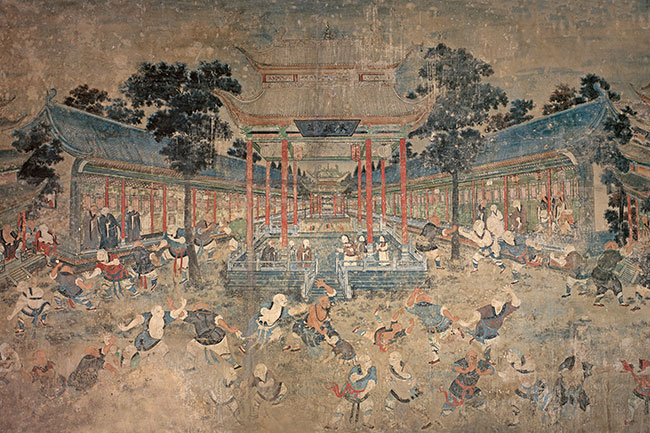
Shaolin Temple mural.
Hung Hei-kwun (洪熙官, 1745–1825), a tea merchant, became a layman-follower at the Fujian Shaolin Temple after abandoning his business due to a dispute with Qing nobles in Guangdong Province. The head of the temple at that time, Abbot Chi Zin (至善禪師), was so impressed with Hung Hei-kwun’s talent and hard work that he even taught him personally. Hung Hei-kwun was eventually ranked as the best of all the layman-followers of the temple at that time.
The Qing Dynasty had always been suspicious of the activities of the Fujian Shaolin Temple, but when one of the layman-followers, Wu Wai-kin, returned to his hometown and fought the Qing nobles in revenge for his father’s death, the Qing Government finally had the excuse they needed to take direct action. The powerful Qing army set fire to the temple and began bombarding the monks with cannons, guns, and arrows. Only about thirty survivors escaped, scattering southward.
Among the survivors were Hung Hei-kwun and his teachers from the temple: the monk Sam Tak and Abbot Chi Zin. After settling in Guangdong Province, Hung Hei-kwun opened a secret martial arts school in Big Buddha Temple to fulfill his responsibility to pass on and spread the Shaolin teachings. Ten years later, he opened a formal school in Fa City. He named it “Hung Gar Boxing” to conceal its Shaolin origins from the Qing Government, and in order to memorialize the first emperor of the the Ming Dynasty, Hung-mo Chu.
Hung Hei-kwun’s school of Hung Gar Kung Fu became widely known and soon the art spread throughout southern China. His former teacher, the abbot Chi Zin, had also fled to Guangdong Province, and when he found out that Hung Hei-kwun had started a school in Fa City, he sent his own follower, Luk Ah-choy (陸亞采), to Hung’s school to further his knowledge. Luk Ah-Choy soon became an expert in the art, and Hung Hei-kwun sent him to Canton to spread Hung Gar Kung Fu.
Wong Tai (黃泰, 1782–1867) was Luk Ah-Choy’s most talented follower, and his son, Wong Kay-ying (黃麒英, c. 1815–1886), also mastered Hung Gar Kung Fu under Luk Ah-Choy. Wong Kay-ying’s skill grew so great that he was regarded as one of the “Ten Tigers of Guangdong” — the ten best martial artists in Guangdong Province. His son, Wong Fei-hung (黃飛鴻, 1847–1924), became so popular in southern China that his life story has since become the subject of hundreds of movies, television shows, and publications.
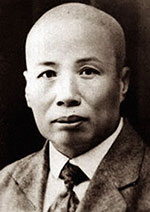
Lam Sai Wing
Wong Fei-hung’s top student was Lam Sai-wing (林世榮, 1861–1942), who took an important role in spreading the art of Hung Gar Kung Fu among the general public. Lam Sai-wing abandoned the secretive practice of past masters and taught all his knowledge to his followers. Thus he provided an example for other masters of his time to follow. Lam Sai-wing also published many books on Kung Fu, and spent much time reorganizing and developing the Hung Gar style to suit the changing times.
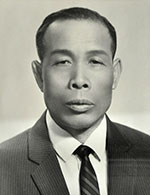
Wong Lei
Wong Lei (王利) was one of Lam Sai-wing’s top disciples who continued the tradition of sharing his knowledge of Hung Gar. John S.S. Leong (梁崇, b. 1937), a senior disciple of Wong Lei, pioneered the introduction of Hung Gar Kung Fu into the United States in 1963 and has continued the tradition for over 50 years.
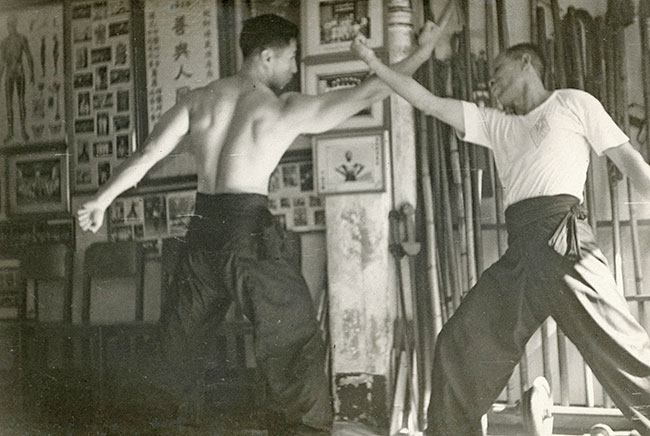
Grandmaster John S.S. Leong practicing a form with Great Grandmaster Wong Lei, Hong Kong, 1960.
For information call:
(206) 624-3838
656½ South King Street
Seattle, WA 98104
Directions »
It is man that makes truth great,
not truth that makes man great.
—Confucius
© Seattle Kung Fu Club

